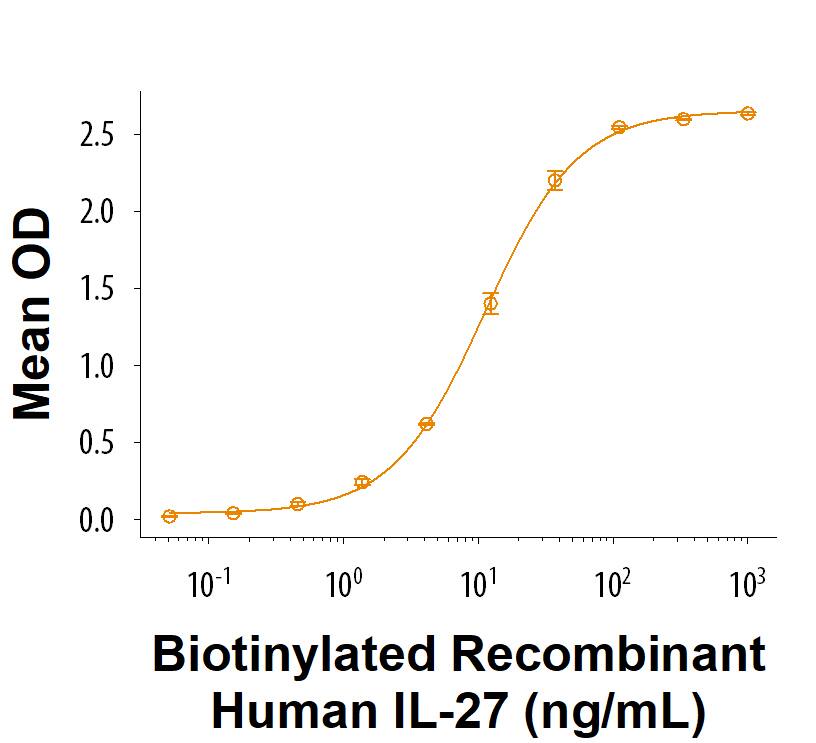Recombinant Human IL-27 His-tag Biotinylated Protein, CF
R&D Systems, part of Bio-Techne | Catalog # BT2526
Biotinylated

Key Product Details
Source
NS0
Accession #
Structure / Form
Biotinylated via amines
Conjugate
Biotin
Applications
Bioactivity
Product Specifications
Source
Mouse myeloma cell line, NS0-derived human IL-27 protein
| Human IL-27 EBI-3 (Arg21-Lys229) Accession # Q14213.2 |
Human IL-27 p28 (Phe29-Pro243) Accession # AAM34498.1 |
6-His tag |
| N-terminus | C-terminus |
Purity
>95%, by SDS-PAGE visualized with Silver Staining and quantitative densitometry by Coomassie® Blue Staining.
Endotoxin Level
<0.10 EU per 1 μg of the protein by the LAL method.
N-terminal Sequence Analysis
Arg21
Predicted Molecular Mass
50 kDa
SDS-PAGE
55-64 kDa, under reducing conditions.
Activity
Measured by its binding ability in a functional ELISA.
When Recombinant Human IL-27 Ra/WSX-1/TCCR Fc Chimera Protein (Catalog # 1479-TC) is immobilized at 0.500 μg/mL (100 μL/well), Biotinylated Recombinant Human IL‑27 His-tag (Catalog # BT2526) binds with an ED50 of 4.00‑40.0 ng/mL.
When Recombinant Human IL-27 Ra/WSX-1/TCCR Fc Chimera Protein (Catalog # 1479-TC) is immobilized at 0.500 μg/mL (100 μL/well), Biotinylated Recombinant Human IL‑27 His-tag (Catalog # BT2526) binds with an ED50 of 4.00‑40.0 ng/mL.
Scientific Data Images for Recombinant Human IL-27 His-tag Biotinylated Protein, CF
Recombinant Human IL-27 His-tag Biotinylated Protein Binding Activity.
Measured by its binding ability in a functional ELISA. When Recombinant Human IL-27 Ra/WSX-1/TCCR Fc Chimera Protein (1479-TC) is immobilized at 0.500 μg/mL (100 μL/well), Recombinant Human IL‑27 His-tag Biotinylated Protein (Catalog # BT2526) binds with an ED50 of 4.00‑40.0 ng/mL.Recombinant Human IL-27 His-tag Biotinylated Protein SDS-PAGE.
2 μg/lane of Recombinant Human IL-27 His-tag Biotinylated Protein (Catalog # BT2526) was resolved with SDS-PAGE under reducing (R) and non-reducing (NR) conditions and visualized by Coomassie® Blue staining, showing bands at 55-64 kDa.Formulation, Preparation and Storage
BT2526
| Formulation | Lyophilized from a 0.2 μm filtered solution in HEPES, NaCl, EDTA and CHAPS with Trehalose. |
| Reconstitution | Reconstitute at 100 μg/mL in sterile water. |
| Shipping | The product is shipped at ambient temperature. Upon receipt, store it immediately at the temperature recommended below. |
| Stability & Storage | Use a manual defrost freezer and avoid repeated freeze-thaw cycles.
|
Background: IL-27
References
- Boulay, J-L. et al. (2003) Immunity 19:159.
- Trinchieri, G. et al. (2003) Immunity 19:641.
- Murakami, M. et al. (2004) Growth Factors 22:75.
- Cordoba-Rodriguez, R. and D.M. Frucht (2003) Exp. Opin. Biol. Ther. 3:715.
- Devergne, O. et al. (1996) J. Virology 70:1143.
- Pflanz, S. et al. (2002) Immunity 16:779.
- Villarino, A.V. et al. (2004) J. Immunol. 173:715.
- Pflanz, S. et al. (2004) J. Immunol. 172:2225.
- Scheller, J. et al. (2005) Biochem. Biophys. Res. Commun. 326:724.
- Holscher, C. (2004) Med. Microbiol. Immunol. (Berl).193:1.
Long Name
Interleukin 27
Alternate Names
IL27
Gene Symbol
IL27
UniProt
Additional IL-27 Products
Product Documents for Recombinant Human IL-27 His-tag Biotinylated Protein, CF
Product Specific Notices for Recombinant Human IL-27 His-tag Biotinylated Protein, CF
For research use only
